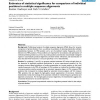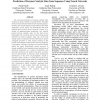33 search results - page 3 / 7 » Accurate prediction of ATP-binding residues using sequence a... |
BMCBI
2004
13 years 5 months ago
2004
Background: Profile-based analysis of multiple sequence alignments (MSA) allows for accurate comparison of protein families. Here, we address the problems of detecting statistical...
BMCBI
2008
13 years 5 months ago
2008
Background: We present a novel method of protein fold decoy discrimination using machine learning, more specifically using neural networks. Here, decoy discrimination is represent...
CIBCB
2007
IEEE
13 years 9 months ago
2007
IEEE
The accurate prediction of enzyme catalytic sites remains an open problem in bioinformatics. Recently, several structure-based methods have become popular; however, few robust seq...
BMCBI
2006
13 years 5 months ago
2006
Background: Several entropy-based methods have been developed for scoring sequence conservation in protein multiple sequence alignments. High scoring amino acid positions may corr...
BMCBI
2006
13 years 5 months ago
2006
Background: The majority of peptide bonds in proteins are found to occur in the trans conformation. However, for proline residues, a considerable fraction of Prolyl peptide bonds ...


